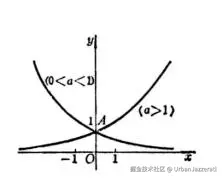指数函数是数学中常见的一类函数,形式通常为 <math xmlns="http://www.w3.org/1998/Math/MathML"> f ( x ) = a x f(x) = a^x </math>f(x)=ax,其中底数 <math xmlns="http://www.w3.org/1998/Math/MathML"> a a </math>a 是常数 <math xmlns="http://www.w3.org/1998/Math/MathML"> ( a > 0 且 a ≠ 1 ) (a>0且 a≠1) </math>(a>0且a=1),自变量 <math xmlns="http://www.w3.org/1998/Math/MathML"> x x </math>x 是指数。以下是关于指数函数的详细说明,适合初学者理解:
1. 基本形式
-
标准形式: <math xmlns="http://www.w3.org/1998/Math/MathML"> y = a x y = a^x </math>y=ax
- <math xmlns="http://www.w3.org/1998/Math/MathML"> a a </math>a 称为底数(base),是正实数且不等于 1(因为 <math xmlns="http://www.w3.org/1998/Math/MathML"> a = 1 a=1 </math>a=1 时函数退化为常数函数 <math xmlns="http://www.w3.org/1998/Math/MathML"> y = 1 y=1 </math>y=1)。
- <math xmlns="http://www.w3.org/1998/Math/MathML"> x x </math>x 是指数(exponent),可以是任意实数。
-
常见特例:自然指数函数 <math xmlns="http://www.w3.org/1998/Math/MathML"> y = e x y = e^x </math>y=ex,其中 <math xmlns="http://www.w3.org/1998/Math/MathML"> e ≈ 2.71828 e≈2.71828 </math>e≈2.71828(自然常数)。
2. 定义域和值域
- 定义域 :所有实数( <math xmlns="http://www.w3.org/1998/Math/MathML"> x ∈ R x∈R </math>x∈R),因为任何实数指数都有定义(例如 <math xmlns="http://www.w3.org/1998/Math/MathML"> a − 2 = 1 a 2 , a 0.5 = a a^{-2} = \frac{1}{a^2},a^{0.5} = \sqrt{a} </math>a−2=a21,a0.5=a )。
- 值域 :正实数( <math xmlns="http://www.w3.org/1998/Math/MathML"> y > 0 y>0 </math>y>0),即函数值始终为正。
3. 图像特征
-
当 <math xmlns="http://www.w3.org/1998/Math/MathML"> a > 1 a>1 </math>a>1时:
- 函数单调递增(即 <math xmlns="http://www.w3.org/1998/Math/MathML"> x x </math>x 增大, <math xmlns="http://www.w3.org/1998/Math/MathML"> y y </math>y 增大)。
- 图像过点 <math xmlns="http://www.w3.org/1998/Math/MathML"> ( 0 , 1 ) (0,1) </math>(0,1)(因为 <math xmlns="http://www.w3.org/1998/Math/MathML"> a 0 = 1 a^0 = 1 </math>a0=1)。
- 随着 <math xmlns="http://www.w3.org/1998/Math/MathML"> x → − ∞ , y → 0 x→−∞,y→0 </math>x→−∞,y→0(趋近于 x 轴但不接触);随着 <math xmlns="http://www.w3.org/1998/Math/MathML"> x → + ∞ , y → + ∞ 。 x→+∞,y→+∞。 </math>x→+∞,y→+∞。
-
当 <math xmlns="http://www.w3.org/1998/Math/MathML"> 0 < a < 1 0<a<1 </math>0<a<1 时:
- 函数单调递减。
- 同样过点 <math xmlns="http://www.w3.org/1998/Math/MathML"> ( 0 , 1 ) (0,1) </math>(0,1)。
- <math xmlns="http://www.w3.org/1998/Math/MathML"> 随着 x → − ∞ , y → + ∞ ;随着 x → + ∞ , y → 0 。 随着 x→−∞,y→+∞;随着 x→+∞,y→0。 </math>随着x→−∞,y→+∞;随着x→+∞,y→0。

4. 重要性质
-
指数法则(运算法则):
- <math xmlns="http://www.w3.org/1998/Math/MathML"> a m ⋅ a n = a m + n a^m \cdot a^n = a^{m+n} </math>am⋅an=am+n
- <math xmlns="http://www.w3.org/1998/Math/MathML"> a m a n = a m − n \frac{a^m}{a^n} = a^{m-n} </math>anam=am−n
- <math xmlns="http://www.w3.org/1998/Math/MathML"> ( a m ) n = a m ⋅ n (a^m)^n = a^{m \cdot n} </math>(am)n=am⋅n
- <math xmlns="http://www.w3.org/1998/Math/MathML"> a − n = 1 a n a^{-n} = \frac{1}{a^n} </math>a−n=an1
- <math xmlns="http://www.w3.org/1998/Math/MathML"> a 1 / n = a n a^{1/n} = \sqrt[n]{a} </math>a1/n=na
5. 实际应用
- 复利计算:本金 <math xmlns="http://www.w3.org/1998/Math/MathML"> P P </math>P 以年利率 <math xmlns="http://www.w3.org/1998/Math/MathML"> r r </math>r 连续复利, <math xmlns="http://www.w3.org/1998/Math/MathML"> t t </math>t 年后总额为 $A = P e^{rt}v。
6. 常见误区
- 指数函数 <math xmlns="http://www.w3.org/1998/Math/MathML"> a x a^x </math>ax 与幂函数 <math xmlns="http://www.w3.org/1998/Math/MathML"> x a x^a </math>xa不同:前者指数是变量,底数是常数;后者底数是变量,指数是常数。
- 注意底数 <math xmlns="http://www.w3.org/1998/Math/MathML"> a a </math>a 必须为正(负底数可能导致无定义,如 <math xmlns="http://www.w3.org/1998/Math/MathML"> ( − 2 ) 0.5 (-2)^{0.5} </math>(−2)0.5 不是实数)。
7. 简单例子
-
<math xmlns="http://www.w3.org/1998/Math/MathML"> f ( x ) = 2 x : f(x) = 2^x: </math>f(x)=2x:
- <math xmlns="http://www.w3.org/1998/Math/MathML"> f ( 0 ) = 1 , f ( 1 ) = 2 , f ( 2 ) = 4 , f ( − 1 ) = 0.5 f(0)=1, f(1)=2, f(2)=4, f(−1)=0.5 </math>f(0)=1,f(1)=2,f(2)=4,f(−1)=0.5
-
<math xmlns="http://www.w3.org/1998/Math/MathML"> g ( x ) = ( 1 2 ) x : g(x) = \left(\frac{1}{2}\right)^x: </math>g(x)=(21)x:
- <math xmlns="http://www.w3.org/1998/Math/MathML"> g ( 0 ) = 1 , g ( 1 ) = 0.5 , g ( 2 ) = 0.25 g(0)=1, g(1)=0.5, g(2)=0.25 </math>g(0)=1,g(1)=0.5,g(2)=0.25